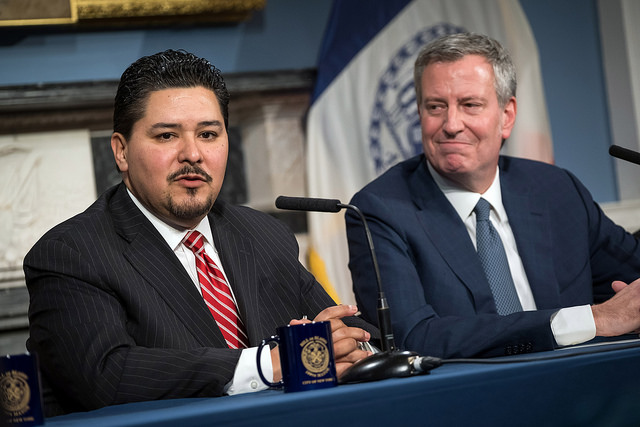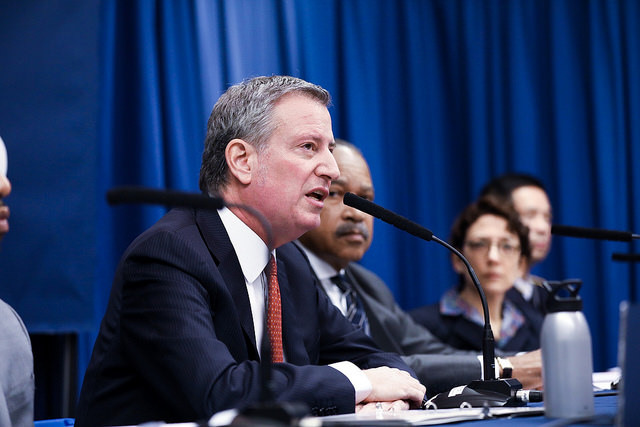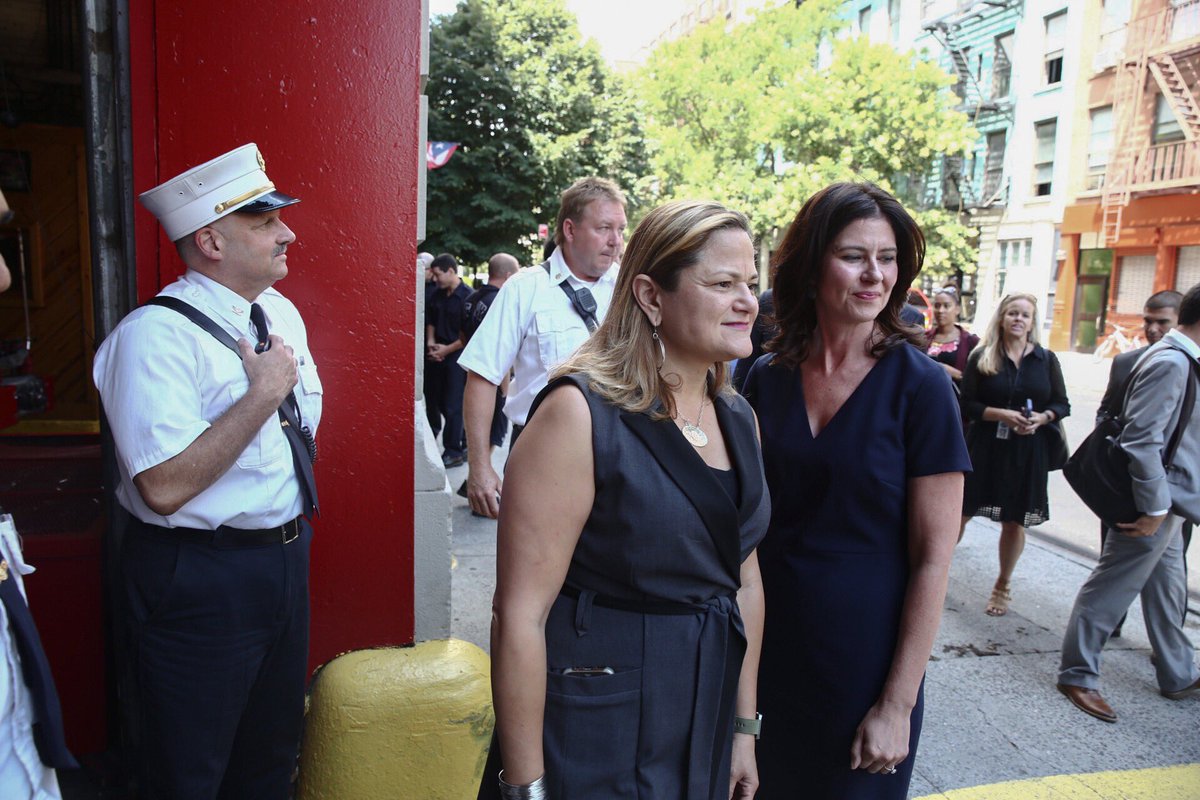Let Carranza Lead

Mayor de Blasio and Chancellor Carranza (photo: Ed Reed/Mayor's Office)
According to press reports, Mayor de Blasio, First Lady McCray, and First Deputy Mayor Fuleihan were the key decision-makers in appointing our new schools Chancellor, Richard Carranza. They now must let Carranza lead.
De Blasio had worked with Carmen Fariña for decades, so her appointment was a no-brainer. But when it came to finding her replacement, his secretive process blew up. Alberto Carvalho, the mayor’s first choice, publicly repudiated the job after taking it, reportedly because City Hall attached strings to his hiring authority. The micro-managers are now doing the same to Carranza. It has to stop.
First, soon-to-be-former Chancellor Fariña appointed herself to some ambiguous job placating warring co-located schools. Then Aimee Horowitz, the senior administrator for the beleaguered Renewal Schools program, was transferred from that post to assist Fariña’s efforts.
Installing the old chancellor in another job and reshuffling other leadership positions before Carranza arrives belittles an already hobbled second-choice candidate.
Mayoral control should not mean that chancellors become lap dogs to political expediency. In setting an agenda of continuity from on high, the mayor is sacrificing educational improvement to claim his previous education agenda as the single path to quality.
That’s nonsense. Whatever Fariña’s accomplishments, the system has yawning failures. Barely 40% of 3rd through 8th graders are proficient in reading, fewer than 30% for black and Latino students according to 2017 state test scores. Citywide math scores are even lower, with only one in five black students meeting proficiency standards. Graduation rates stand at about 70%, but only half of grads are deemed “college ready.” Add to that severe shortfalls in educational attainment by students with disabilities, English language learners, and students experiencing homelessness, and the mayor’s rosy picture seems less about progress and more about his next campaign.
Leadership untethered from claims of “Mission Accomplished” is needed for further progress and mid-course corrections. This can’t be done by a mayor wedded to his own record.
First, of course, is giving Carranza the ability to select deputies who know the system but are answerable to him, not City Hall. Next, he needs to be able to speak out not as a ventriloquist’s dummy but as someone who has already led two urban school districts.
Carranza’s statement that there is “no daylight” between him and the mayor better not be true. We are not talking about the Sun God here. De Blasio is prone to mistakes and it is up to Carranza to push back when issues arise, as when he needs to take on the politically powerful teachers union in upcoming contract negotiations.
Then there are policy matters where the mayor needs to take a step back. Carranza actually used the word “segregation” at his initial press conference, something the mayor regularly avoids. Taking on the multiple achievement gaps left to him will mean confronting widespread enrollment issues that de Blasio has so far refused to tackle.
Coming from outside the system after a secret search, a runner-up already scarred by gender-bias allegations and mixed reviews of his previous experience, our new chancellor must bring new thinking and new energy to the table. De Blasio has already done him a disservice by cocooning Carranza, who faces great challenges. But the greater challenge is the mayor’s to let his hand-picked leader lead.
***
David C. Bloomfield is Professor of Educational Leadership, Law and Policy at Brooklyn College and The CUNY Graduate Center. On Twitter @BloomfieldDavid.
***
Have an op-ed idea or submission for Gotham Gazette? Email This email address is being protected from spambots. You need JavaScript enabled to view it.
Cynthia Nixon Should Avoid De Blasio’s Sham Progressivism

Mayor de Blasio (photo: Benjamin Kanter/Mayor's Office))
It is impressive that Mayor de Blasio has succeeded in wrapping himself in the progressive mantle despite the reality of his record. While his rhetoric stakes claim to that mantle, his record fails to merit the honor. As the old saying goes, actions speak louder than words -- or should, at least.
Perhaps it is additionally important now to scrutinize that record since it is commonly understood that Governor Andrew Cuomo's well-publicized challenger from the left, Cynthia Nixon, will campaign very much in the spirit of de Blasio's first mayoral run in 2013, which she intensely supported.
His policing policies alone, involving starkly racially-biased "broken windows" tactics, undercut the political identity that he seeks and that many journalists grant him. These practices target people of color daily for petty infractions that have been virtually decriminalized in white areas.
Relevant facts include: 85 to 95% of NYPD misdemeanor arrests involve New Yorkers of color, including 91% of marijuana possession arrests -- despite research findings that white people use and sell the drug in equal or greater proportions to African-Americans and Latinos -- and 91.5% of fare-beating arrests, which is the third most common NYPD arrest. About 95% of NYPD juvenile arrests involve black and brown youth. About 90% of persons confined on Rikers Island are African-American and Latino, and they are there for two main reasons: they're too poor to afford bail and an NYPD officer has arrested them.
A major area where de Blasio has failed to meet the needs of disadvantaged New Yorkers -- supposedly a key part of his base -- is our city's dual, related crises: homelessness and the lack of affordable housing. Again, facts: over 63,000 people live in our homeless shelters, an increase of about 13,000 since de Blasio took office; over 90% of our homeless families are African-American or Latino; and research shows that lack of affordable housing is the primary cause of homelessness.
De Blasio's most recent proposal regarding homelessness, made last year, entails opening 90 new shelters over the next five years with the modest goal of reducing the number of homeless people by 2,500. Possibly trying to trick us into thinking that the plan would have a significant effect, he called it "Turning the Tide on Homelessness." More like "Flying the White Flag of Surrender."
In 2014 de Blasio unveiled a plan to build or preserve 200,000 affordable housing units. He touts its success as a major progressive achievement of his first term. Yet even the city's own numbers show that the plan has not resulted in providing truly affordable housing for New Yorkers who need it most. The de Blasio administration has stated that the city has nearly 1 million households earning less than $42,000 per year, and we know that New York has only 425,000 units that these households can afford. Despite this shortfall, 80% of the so-called affordable units created in de Blasio's plan will be unaffordable for these low-income households.
A central problem is that de Blasio's plan artificially inflates what's considered "affordable," measuring a household’s eligibility by an Area Median Income (AMI) that includes all five boroughs and comparatively wealthy counties outside of the city: Westchester, Putnam, and Rockland. This card trick masquerading as fair practice opens the door for developers to build housing that ends up displacing families it supposedly serves.
On other liberal litmus test issues, de Blasio grades an “F.” He's failed to dismiss, as he has the power to, any of the officers whose reckless conduct contributed directly to Eric Garner's death; refused to include in the city budget money to support reduced or free subway and bus fares for poor New Yorkers -- instead, his police department arrests them; substantially ducked pressure to diversify our public schools, the country's third most segregated system; in response to credible charges that his administration engaged regularly in "pay-to-play" transactions benefitting major donors, promised to publish a list of wealthy contributors who received no government favors, then failed to do so; despite loud outcry by public defender groups, refused to provide legal representation to immigrant New Yorkers facing deportation convicted of felonies no matter how long ago.
De Blasio's record also exposes his tenuous relationship with facts. He's publicly repeated that the NYPD has ended most marijuana possession arrests, when last year it made 17,880. He claimed in donor appeals during last year's mayoral race that "special interests have spent $13 million to stop us." According to The New York Times, that figure includes $5.8 million that Uber spent in 2015 lobbying to beat back his attempt to limit the number of its cars on the roads. He claims New York as a "sanctuary city" despite his "broken windows" policing putting undocumented New Yorkers at risk of deportation daily.
De Blasio often states that he is the first Democrat elected New York City mayor in 20 years. It's a disingenuous point -- his predecessor Mike Bloomberg was a life-long Democrat who switched party affiliation to run for mayor in 2001 and who supported many standard liberal positions, such as on abortion, gay rights, gun control, and immigration. Even the notoriously law-and-order mayor from the ‘90s, Rudy Giuliani, backed most of those stances, too.
As the truth sets in, more New Yorkers see past the mayor's liberal rhetoric and recognize what his record reveals, that he is a mainstream, opportunistic politician. Cynthia Nixon, who's had an impressive early run out of the gate, confronts an important political call. To maintain her credibility as a progressive alternative to the governor, she must put some distance between herself and her old friend de Blasio.
For example, she must call for an end to biased and abusive "broken windows" policing and for dismissing the officers involved in the Eric Garner incident. She must promote free or reduced public transit fares for low-income New Yorkers and an aggressive plan to desegregate our public schools. She must call out and take on big real estate and propose an affordable housing plan that provides units that people living in poor communities can actually afford.
Finally, Nixon cannot lay a blanket charge of corruption just on Cuomo when evidence of "pay-to-play" governance has clearly tarnished the de Blasio administration. Taking such steps will increase her standing as an outspoken progressive with broad appeal for the voters likely to cast ballots in the Democratic primary in September. in addition to being strategic politically, it has the advantage of being the right thing to do.
**
Bob Gangi is the director of the Police Reform Organizing Project (PROP). On Twitter @GangiFromPROP.
***
Have an op-ed idea or submission for Gotham Gazette? Email This email address is being protected from spambots. You need JavaScript enabled to view it.
How the 21 in ‘21 Movement to Elect Women Will Be Successful

Mark-Viverito, left, and Crowley, the authors (photo: @NYCCouncil)
Susan B. Anthony said in 1897, “There will never be complete equality until women themselves help make laws and elect lawmakers.”
Thanks in part to Anthony’s life work and that of her fellow suffragettes, American women now have the power both to vote and serve as lawmakers. Yet, more than 120 years later, Anthony’s dream of complete equality has not been realized, because of the profound disparity in representation between men and women in elected office.
During our years as members of the New York City Council, we saw the number of women in the Council decline from a high of 18 in 2009 to its current number of 11.
Why should New Yorkers care about the underrepresentation of women in the city’s legislature? Our experience in the Council serving on the governing team that oversees the spending of your tax dollars is perhaps the biggest reason.
The city budget is over $85 billion and the Council has oversight over nearly 130 different government offices and agencies and nearly 300,000 full-time city employees. How this money is spent and these critical resources are managed reflects the makeup of the city’s elected officials. When over 78% of the Council’s members are men, male points of view dominate the discourse in the halls of government, even though a majority of New Yorkers—52%—are women.
Fortunately, there is a new awareness across the nation that women will not be equal until they have equal say in the most important decisions that affect their lives. One reason for this awakening is the election of a president who revels in his misogyny, has bragged about sexually assaulting women, and continues to show contempt for women in office, filling his cabinet with the highest percentage of men of any president since George W. Bush in his first term.
To do our part locally in the fight for complete equality, we co-founded the 21 in ’21 Initiative, a nonpartisan effort that aims to achieve gender parity in the New York City Council, starting by increasing the number of women in the Council to at least 21 through the next city election cycle, with votes cast in 2021.
While this goal is ambitious, it is attainable mainly because of two factors: term limits and the city’s campaign finance system, which includes a significant public matching fund program.
In 2021, 36 of the Council’s 51 seats will be vacant because of term limits. Without an incumbent office holder, these seats are much more winnable, particularly for a candidate who has spent years preparing to run. That’s why nearly four years out from Election Day, we’re already building the infrastructure and recruiting the candidates we’ll need to accomplish our mission of electing a minimum of 21 women to the Council in 2021.
It will be a challenge, but it is possible, and the work is well underway.
The best part of New York City’s electoral system is that you don’t have to be rich or have wealthy friends to become a successful candidate. That’s because the city’s Campaign Finance Board matches every dollar donated to your campaign up to $175 at a six-to-one ratio, turning, for instance, a $10 donation into $70. This system empowers women from every neighborhood and every background to step up and vie to represent their communities in the Council.
The main reason that more women aren’t elected officials is that far fewer women become candidates. Studies show that when women do run, they win at a comparable rate to men, despite additional barriers. While there are several factors that deter women from running, a large one is that women aren’t generally brought up in a way that inclines them to self-select as candidates the way men do.
We grew up in women-led households, in which our mothers made the decisions for our family. They were leaders that instilled in their daughters the belief that serving in public office was the noblest of professions. We were lucky to have mentors like our mothers.
It is this model of strong mentorship that is at the core of the 21 in ’21 Initiative. We have already built a top-notch network of mentors to strengthen and support female candidates.
21 in ’21 is here for the women ready to become the future leaders of our city, but all New Yorkers must contribute in order for Susan B. Anthony’s dream to become a reality. From the voting booth to our block associations, and our political clubs to our community boards and of course to the New York City Council and beyond, we must all demand equal representation now.
***
Melissa Mark-Viverito and Elizabeth Crowley are former City Council members and co-founders of 21 in ‘21. Mark-Viverito was the Council Speaker from 2014 through 2017. On Twitter @MMViverito and @ElizCrowleyNYC.
***
Have an op-ed idea or submission for Gotham Gazette? Email This email address is being protected from spambots. You need JavaScript enabled to view it.




